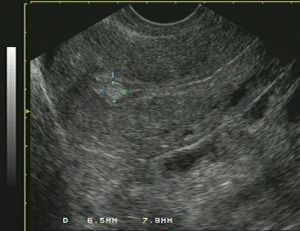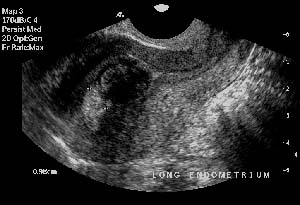Menstrual bleeding usually occurs each 28 days. Sometimes the cycle may be longer or shorter than 28 days. At times the cycle may be very irregular, or bleeding may become very heavy. This may just be due to a temporary hormonal imbalance, but it can be due to problems in the uterus or the ovaries.
A small growth of the tissue of the lining of the uterus (endometrial polyp) can occur. These can cause periods to be heavier or to have bleeding at unusual times. Mostly these are not cancerous, but occasionally if left alone for a long time they can become cancerous. Polyps can usually be seen on transvaginal ultrasound, but a technique called sonohysterography can be used to make them easier to see.
|
 |
| Image of a polyp |
|
Fibroids are a growth arising from the muscle of the uterus. They can press on the lining of the uterus (endometrium) and cause irregular bleeding or heavy periods. It is very rare for a fibroid to become cancerous.
|
 |
| Image of fibroid distorting the endometrium |
|
The ovaries produce hormones which control the uterus. Some conditions can alter the hormonal production and stop the ovaries producing an egg (ovulation) each month. An example of this is polycystic ovarian syndrome.
|
 |
| Image of polycystic ovarian syndrome |
|





